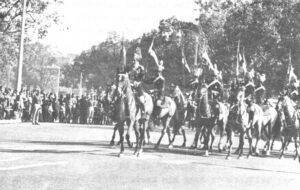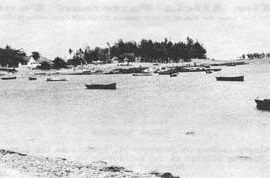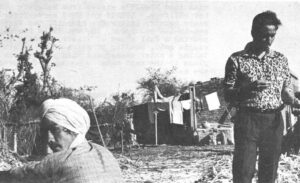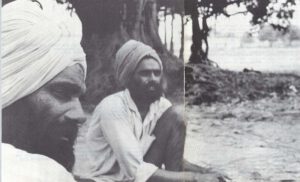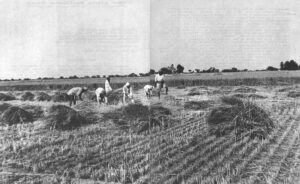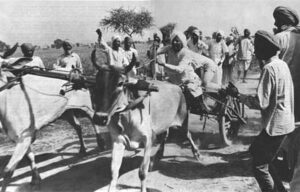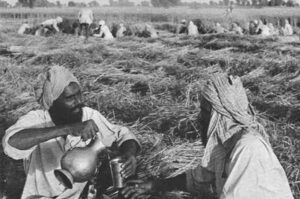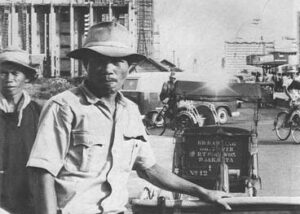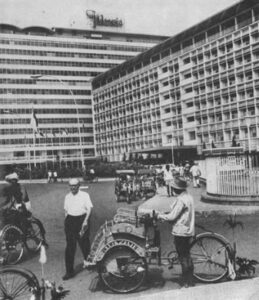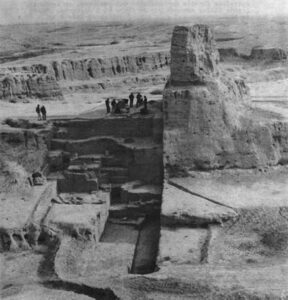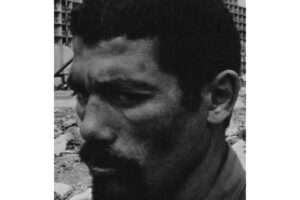New Delhi
February 15, 1970
Pick your step carefully down a crushed cinder path bordered with pink rosebushes that somehow survive the cold north India winter. A patch of sparse green lawn and bare sandstone platform set into a desiccated plain, sunny, brown and empty, with dust lapping up from the banks of the Jumuna River and carling around the red sandstone ramparts of Shah Jehan’s vast-Moghul fortress. Minarets and marble domes, hazed with smoke from a thermal station, form the city skyline over tenements festooned with laundry. There is an air of solemn distinction about the place as three peasants, huddled and shapeless in their cotton shawls and blankets, approach to throw marigolds on the consecrated ground. It is paradoxical, as so much is in India, to see these deeply conservative and religious rustics paying reverence to the avowed agnostic who was so determined to break through their ancient ways to modernization daring the seventeen years he ruled India.
Jawaharlal Nehru, with his sense of form and elegance, might well be appalled by the place of Hindu pilgrimage his cremation ground has become. The original intention, announced just after his death almost six years ago, was to create a cool, green deer park on the site. But wandering cows ate the first plantings and those that. remain, forlorn, shriveled saplings, are enclosed in wire cages. So the place has not changed much since the day after Nehru died. Memories come back easily. The night of the state funeral, when all Delhi seemed to vanish from the streets and into her houses and only a lone Brahmin in a dusty dhoti stirred Nehru’s bones and ashes in what looked like a small ordinary bonfire and the dark plain was a tangled wreckage of twisted steel guardrails and the ghat’s only protection was four soldiers smoking drooping cigarettes. Out of the night rushed a gigantic Sikh, whiskered and turbaned, and he tried to throw himself into the flames, screaming, “Nehru, Nehru!” and he clawed at the bricks as it took all four soldiers to drag him back. Or in the afternoon, the plain then a sea of four or five million human beings, the thundering cries of “May he be immortal!” and those nearest the burning ghat, Alexei Kosygin and Dean Rusk among them, listening to the rumbles of hysteria and the shudder-like whispers when the masses seemed to push forward and you feared going into the fire. or that scene on the grand stairway of Nehru’s old mansion on Teen Murti Marg two days before, as Indira Gandhi and Lal Bahadar Shastri, the two future prime ministers of India, stood helpless and sobbing and stricken as Morarji Desai, ascetic, rigid arch-rival of Nehru, with power now almost within his grasp, remained dry-eyed and level-voiced, taking charge, ordering the servants to, quickly, quickly, bring-cakes of ice and fans to the bedroom.
Nehru’s last few months in office were his finest; an old man determined to die in harness and pat his house in order before he did. It was as if he were, in the words of Chester Bowles, “face to face with God.” This last chapter began, in a spectacle of almost medieval religious passion, with a Moslem revolt in the Vale of Kashmir over the theft of a hair said by legend to be from the beard of the Prophet Mohammed. For ten days the Kashmiris, cut off from the outside world by snowstorms and total censorship, raged through the shattered streets of Srinagar, heavily cloaked against bitter cold and carrying thousands of black flags and the green star and crescent of Islam. On January 5th, 1964, a third-of-a-million Moslems gathered in Srinagar’s historic Red Square where Nehru had promised them self-determination fourteen years before. The snow was falling and in a moment of tumultuous frenzy, the women tore off their veils, sobbing unashamedly and the men fell on their knees and with hands raised to the sky, implored Allah to restore his presence to the valley. As the Pir of Shalimar led the throng in singing hymns a bearded elder shouted, “The ice that has frozen our freedom for ten years has melted. Spring has come to Kashmir even if God has not given the world ears to hear.” At a Congress meeting in distant Bhubaneshwar on the plains, Nehru had his first stroke and tens of thousands of Bengali Moslems and Hindus began looting and killing in communal riots. So it was that Nehru, in the last months of his life, released his former protégé, the long imprisoned Kashmiri leader, Sheikh Abdullah, allowed him to return to the Vale to preach an almost Christian message of forgiveness and brotherly love and go to Pakistan for discussions and did all he could to break the Kashmir deadlock. Three nights before his death, Nehru called in the Kashmiri prime minister, G. M. Sadiq, and said that if a condominium were formed with Pakistan for an autonomous Kashmir so that the Vale could become a bridge and not a wedge between the two nations, would Sadiq agree. “I agreed.” Sadiq told me on the eve of the Indian-Pakistan war a year later, “but Pakistan did not agree.” After his conversation with Sadiq, Nehru left for the resort town of Dehra Dun for two days’ rest. On his return he awoke in the night and suffered his fatal stroke. Two days after the funeral, Ayub Khan rejected Abdullah’s proposal.
The last interview. Nehru had just returned from a rehearsal of the ballet, Ramayana, and although the uremic poisoning that was to kill him had already reached his circulatory system, he was in a good mood and mused on the future of India. “Fascism,” he told me as we sat in his enormous office at the External Affairs Ministry, “is the greatest danger ahead. By this I mean social revolutionary forces trying to achieve their ends by violent and subversive means. By creating at atmosphere of violence and conflict, such forces may arise from any side. They can be Communist, social fascism led by big industrialists or Hindu fascism.” He said he felt his greatest achievement had been the political liberation of Indian women. He saw the hope for the future in India’s Congress party remaining cohesive and dedicated to “favoring India’s have-nots.” Nehru was confident this would happen: “Everybody, conservative or not, mast accept this approach. The mass of people mast rise.”
Perhaps the most moving epitaph to Nehru was written by A. M. Rosenthal:
Sometimes he talked angrily to his India and sometimes he shrieked at it and denounced it and said it was just impossible. Sometimes he courted his India, laughed with it, and was merry and delicate and understanding. But it was always as if Jawaharlal Nehru went looking into the eyes of India and India were just one soul.
Less reverent bat also on the mark were the remarks of a British and Indian journalist during the funeral cortege. “Even in death, he still has that suffer-the-little-children-to-come-onto-me look.” the Britisher said. The Indian replied, “I half expect him to sit up at any moment and say, ‘What is all this nonsense?'”
Rosenthal liked to describe Nehru as “an Indian revolutionary” and denied that he was really “an Englishman in jodphurs.” But anyone might question this visiting Nehru’s old residence today – the prime minister’s mansion has been turned into a museum and glass walls seal off Nehru’s book-lined study and drawing room and bedroom just as he left them. Scribbled on a notepad near Nehru’s bed are perhaps the last words he wrote in his lifetime, the famous lines of Robert Frost:
The woods are lovely, dark and deep
But I have promises to keep
And miles to go before I sleep
And miles to go before I sleep
Bury the dead. Already in Delhi today Nehru seems to be a distant historical figure. In death, his once almost magical grip on the imagination of the great masses of the people seems to have vanished. Perhaps the loss of the Congress party’s old aathority, the faded hopes of swift economic advance, the shattered panch shila policy with its dream of a peaceful, nonaligned Asia, are too close and contemporary. Mahatma Gandhi is still a pervasive influence in Indian political life end frail, gentle little Shastri is remembered as a war hero. But one senses more years will have to pass before the Indians fully credit Nehru for the stability that made it possible for this vast, most diverse, backward and problem-ridden of all nations, whose population equals all the 60-odd states of Africa and Latin America put together, to operate a genuinely democratic constitution, to uphold civil liberties, freedom of the press and the independence of the judiciary. It may soon become clear, perhaps even this year, to what extent Nehru’s long tenure had in easing India through the turbulence that afflicted most other newly independent countries or whether it merely postponed the trouble. Much will depend, again paradoxically, on Nehru’s only child, his daughter, Indira.
West of the Nehru memorial beside the Jumuna has been built an embankment to guard against the river flooding its banks daring the summer monsoon rains; here one can walk, as it were, a little above the whole country, seeing what seems to be all India spread out to left and right. Across the river, where the open country begins, one can behold the many-yoked grain and cotton wagons, with their complaining axles and the shouts and yells of the carters, reviling each other with obscenities as they dodge in and out of the big goods trucks. One can also watch the crowds, little clumps of red and yellow and pink and white and saffron, dispersing from the main road and growing small by twos and threes across the flat, village studded plain. And what incomparable crowds they are! What variety of faces, clothes, gestures, language. What diversity of styles and costumes, dazzling white toga beside rumpled pin-stripe, silken sari beside gypsy skirt. Crossing the great Jumuna Bridge are men from the Himalayan foothills, short, muscular and Mongoloid, expressionless and slant-eyed; Moslem women shrouded from head to foot in their suffocating burkhas; dark-skinned Dravidians from Madras and the Coromandel Coast; fierce mustached Rajput horse traders from the sandy deserts of Ganganagar; wild-eyed blue-turbaned and long-bearded Akalis from the sacred Golden Temple of the Sikhs at Amritsar, gaily dressed villagers on holiday, with women carrying babies on their hips, walking behind the men. There are pilgrims from Nagaland and Kerala, Mysore and Orissa, Tibetan monks from Nepal and Darjeeling; bands of soldiers in olive drab, straight-backed and lithe from maneuvers in the hills; Hindu sadhus, some of them European and American these days, rake-thin in their flowing saffron, bare feet and cow dung-caked hair; shepherds chivvying their sheep toward the slaughterhouse and children, torrents of children. A flock of Rajastani changars, women earth carriers perhaps on their way to work on one of Delhi’s rising skyscrapers, moving in concert across the bridge in a blaze of orange and blue cotton and a jangling din of bracelets, bangles, necklaces, anklets, charms and earrings.
Delhi is indeed an imperial city, ruling a fantastic variety of peoples and provinces – Kutch to Nagaland, Arabian Sea to Tibetan frontier. Delhi looks to the south, to the great Gangetic Plain, the Deccan Plateau and the steamy tropical coasts where most Indians live. But she also casts an uneasy glance back over her shoulder, her eyes on the hills; the Russians now have eight divisions massed between the Urals and Lake Baikal and the Chinese forces are poised to defend their nuclear testing grounds at Lop Nor. Sinkiang, where, if Russia made a preemptive attack on China, it would happen, is only 700 miles north of Delhi.
Delhi has been the central point of empire for longer than history remembers and greatness comes easily to her. Here, before the Moslem conquers stormed across India in the eleventh century, the monarchs of Hindu legend built their shimmering capital of Indraprastha and Ashoka, the emperor-apostle of Buddhism, left two great pillars describing the happiness to be found in the knowledge of the Way. Here the rulers of the Slave Dynasty erected the gigantic tower of victory called the Kutb Minar, still standing talismanic in the spreading, jerry-built suburbs that are now surrounding it. The successive capitals of Lal Kot, Jahanpanah, Siri, Tughlaquabad, Firozabad, Purana Quila, Shahjahanabad, the seven cities of Delhi, were all built on this tremendous site; the Tughlak dynasty rose and waned here, and the Sayyid, and the Lodi, and when the Moghuls established their empire in Hindustan, it was in Delhi that Shah Jehan built the Red Fort, home of the Peacock Throne, one of the greatest fortresses on earth. The centuries have never left Delhi alone; it has been ruled by 22 kings, eleven Hindu and Moslem dynasties, five English sovereigns and eight viceroys, three prime ministers and now the first woman ruler in its history. Timur, Babur, Jahangir and Aurangzeb, war-like and following the banner of the Prophet, poured down from Central Asia and the high valleys of Afghanistan, in the footsteps of Alexander the Great, razing and raping the city, moving her inhabitants in and out, and leaving behind mosques, fortresses and towns, named after themselves and each vying with each other for ever more magnificent monuments to preserve their fame far into the future. Nadir Shah the Persian captured Delhi in 1739, Ahmed Shah Durrani the Afghan in 1757, Mahdo Rao Scindia the Mahratta in 1171, General Lake of His Majesty’s Army in 1803, the blood-crazed sepoys of the Indian Mutiny in 1857 and it was on the plains of Delhi where King George V chose to be crowned Emperor of India in 1911.
It seems inevitable that when the British cast around for a new Imperial capital in the early twentieth century, it was to Delhi’s Raisana Hill they sent Sir Edwin Lutyens and Herbert Baker, commissioned to erect a new Acropolis to the dazzling but short-lived British raj. The new Delhi, the architects said, “must not be Indian, nor English, nor Roman, but it must be imperial,” Fifty years later Le Corbusier scoffed at what he called its Florentine style but he did not deny New Delhi’s magnificence. And so arose, in noble proportions, spacious and generous like the country itself, the eighth and present Delhi, with its mighty tree-lined avenues and gardens dominated by the palace of the Viceroy and now the President, with its white domes and immense red sandstone substructure, the giant Secretariat offices and the immense ceremonial mall, along which, on January 26th, Republic Day, the splendid troops of India march, horsemen and camel riders gorgeously caparisoned, elephants, turbaned infantry and folk dancers from every corner of this vast land.
The past weighs heavily in Delhi, littered with the relies of a dozen kingdoms, crumbled mosques or broken pavilions, stamps of columns and dust-heaps of forts, making the city a cemetery for petty tyrants and past dictators. One can only imagine, in the once again lovingly cared-for gardens of the Red Fort, the splendor of the Moghul court at its height, the processions of the great ones of empire, the musicians, the parades of horses, camels and elephants, the murmur of the fountains, the graceful beauties of the harem. A Persian inscription in one audience hall still declares:
If there be paradise on the face of earth
It is this, oh! it is this, oh! it is this!
But it is not really the past that fosters that powerful sense of significance, the feeling of arriving again in civilization, of getting back in the big time, that you get driving in from Palam Airport. Athens, Cairo, Nairobi, Karachi, Bangkok, Saigon are all exciting cities but today they have a second-rate, next-best air about them, the stale sense of restricted freedoms and squabbling generals and politicians. Delhi is awe-inspiring because she is hot just another autocracy; after twenty-two years she remains the scene of a supreme experiment: the mounting of a social, agricultural and industrial revolution within a free society on a scale staggering to conceive among a community of peoples as traditionally caste-ridden, proud, superstitious and divided as any on earth.
Today, if you stand on Raisana Hill, you, feel only a sense of contemporary grandeur; look to the west and you can see evidence of Delhi’s importance in the diplomatic enclave – the American Embassy resplendent in its fountains, pools and Edward Stone’s imaginative grillwork with its clean lines and golden pillars. Fittingly enough, the Americans are flanked by the Russians and the Chinese, both in massive, high-walled grey fortresses with red flags flying overhead. The Chinese have painted enormous red letters across the facade of one building: “Long Live Chairman Mao!” Delhi shrugs; she does not harbor recriminations and what she may lack in charity she makes up in tolerance.
And to your left, from Raisana Hill, you can see the circular pillared palace of Parliament, with its open rotunda half-a-mile long. This is the real heart of India. Here sits a body of 523 varied, argumentative souls who represent the only authentically democratic assembly between Rome and Tokyo. It is a body often unruly, noisy, testy, childish, bickering, hypocritical and just plain uncouth at times. Some days its debates end in shouting matches and it has known fist fights and manhandling in the halls. But it is the very point and purpose of Delhi and makes her a far greater capital today than she has ever been before, in all the grandeur of her past reincarnations.
Some years back, the London Economist, asked of India, “Well, which is it? The world’s largest democracy and the light of Asia, or a crumbling ant heap of starving people and starved cows?”
The pictures that flash into one’s mind when he thinks of India spring from so many memories and experiences – Sabu on an elephant; a self-righteous lecture from an Indian acquaintance on the decline of American morality; Myrna Loy dying of cholera on the late show; pictures in Newsweek captioned “Rioting and poverty in Calcutta;” learning by rote, “You’re a better man then I am, Gunga Din;” old 1930’s newsreels of Mahatma Gandhi, striding into Buckingham Palace like a “naked fakir” in a loincloth; Indira Gandhi, looking imperious and haggard and motherly to all those hungry millions; Nehru sitting on a fence or his Himalayan humiliation; Bulganin and Khrushchev being garlanded by happy children; or the horrible mental images of Katherine Mayo’s Mother India with its temple prostitution, infanticide, child marriage, untouchability, ignorance, cow worship, disease and filth; or the India of Kipling’s Kim with its fragrant bazaars and exotic moonlit cities and the wonderful adventurous days out on the Brand Trunk Road when Kim is “in the seventh heaven of joy.”
For many the image of India is that described by E. M. Forster in A Passage to India, depicting the imagined city of Chandrapore:
The very wood seems made of mad, the inhabitants of mad moving. So abased, so monotonous is everything that meets the eye, that when the Ganges comes down it might be expected to wash the excrescence back into the soil. Houses do fall, people are drowned and left rotting, but the general outline of the town persists, swelling here, shrinking there, like some low bat indestructible form of life.
I had lived in India almost four years when I first read A Passage to India and had one flash of recognition after another of things I had felt but not articulated. In retrospect, perhaps nothing quite describes India so well, or the foreigner’s difficulty in relating to it, as a memorable paragraph describing how Forster’s heroine, Adele Quested, is struck by the appearance of a humble Indian palling the ceiling fan. The scene, especially familiar since it was dramatized on Broadway a few years ago, takes place daring the courtroom trial of a Westernized Indian doctor accused by Miss Quested of rape. The reader is aware that the rape was an hallucination suffered by Miss Quested daring a visit to some eaves near Chandrapore, Pressed by the local English community, which has made the case a test of white supremacy, Miss Quested has allowed herself to bring formal charges against the doctor, although her inner doubts remain.
The trial is underway and Miss Quested’s eye falls on the punkah wallah:
Almost naked and splendidly formed, he sat on a raised platform near the back…and he caught her attention as she came in, and he seemed to control the proceedings. He had the strength and beauty that sometimes come to flower in Indians of low birth. When that strange race nears the dust and is condemned as untouchable, then nature remembers the physical perfection that she accomplished elsewhere, and throws out a. god – not many, but one here and there, to prove to society how little its categories impress her. This man would have been notable anywhere; among the thin-hammed, flat-chested mediocrities of Chandrapore, he stood out as divine, yet he was of the city, its garbage had nourished him, he would end on its rubbish heaps. Falling the rope towards him, relaxing it rhythmically, sending swirls of air over others, receiving none himself, he seemed apart from human destinies, a male fate, a winnower of souls. Opposite him, also on a platform, sat the little assistant magistrate, cultivated, self-conscious and conscientious. The punkah wallah was none of these things; he scarcely knew he existed and did not understand why the Court was fuller than usual, indeed he did not know it was fuller than usual, didn’t even know he worked a fan, though he thought he pulled a rope. Something in his aloofness impressed the girl from middle-class England, and rebuked the narrowness of her sufferings. In virtue of what had she collected this roomful of people together? Her particular brand of opinions, and the suburban Jehovah who sanctified them – by what right did they claim so mach importance in the world, and assume the title of civilization?
Miss Quested withdraws her charges of rape against the doctor, raining herself, breaking her engagement to an English officer and triggering a revolt by the native population against the British colony of Chandrapore.
Forster’s novel was published in 1924, Dr. Mayo’s Mother India in 1927. Yet even when I first visited India in 1959 it was apparent something had happened in India whose beginnings mast have been visible when they wrote more than thirty years earlier. That something was mental fermentation on a national scale. Today, returning, is to discover, in Delhi and the rural villages alike, that this fermentation has produced a strong awakening of desire and political consciousness. What has always mattered most in India was the attitude of its common people. Several years ago the government’s Community Development Program, to get villagers to accept new techniques, new habits, new attitudes toward change and projects, was finally extended to every hamlet in the country – more than 500,000 of them. Similarly, the massive family planning campaigns of the past few years have sensitized the entire population to the issue of birth control, although only a small minority actually practices it.
Today’s attitude is impatient, demanding, almost – still not quite – equalitarian. More and more peasants in their villages and workers in their slams are taking to violence. The papers are daily full of outbreaks of fighting over small local disputes. Mrs. Gandhi has warned of certain revolution if popular aspirations are not rapidly met. As many national leaders see it, the problem stems from the abandonment of one set of values and the failure to achieve completely another set. Some years ago, Durga Das, a leading political commentator, wrote that “Nehru can raise a storm, but he has yet to prove he can direct the whirlwind.” The danger many Indians fear is that the great mass of people will not be content to wait indefinitely upon the processes of law and -parliamentary government, especially with India’s creaky administration wanting everything applied for in triplicate, through proper channels and with a small bribe attached. But if Indians worry about controlling the whirlwind, its very existence is exhilarating to the foreign observer. Indeed, this is the most encouraging sign of progress and change one finds in India today. The punkah wallah now recognizes his rights as a human being and has dropped his rope forever.
Over the years, a great variety of dooms have been predicted for India. It would “go Communist.” be conquered by China, break into entirely separate linguistic states (remember Selig Harrison’s The Dangerous Decades?) or parliamentary government would be overthrown by a military coup or by the communal forces of political Hinduism.
None have come to pass. None, save possibly a Chinese occupation, is still impossible. But most, with the passage of time, look increasingly unlikely.
The Communist spectre is the one that was, and still is, most often raised in the American press. And it is true the present foreign minister, Dinesh Singh, a rich Westernized maharajah whom Stalin’s daughter, Svetlana Alliluyeva, found a total autocrat, does sometimes take a Soviet line on policy issues not directly affecting India. It is extremely irritating to see Mrs. Gandhi dignify Hanoi’s new shadow Viet Cong government with an audience. And it is also true that Mrs. Gandhi has apparently decided she can best whip up support and insure her own political survival by campaigning against the big Indian industrial houses and making such “socialist” gestures as the nationalization of India’s banks.
But appearances are deceptive. In the face of much opposition, Mrs. Gandhi recently gave the House of Birla the go-ahead to build a $600 million fertilizer plant in Goa, which will be the biggest in the country. Birla, Tata and some twenty more giant business corporations now virtually control India’s chemical industry and about half of all private investment capital. Ashoka Mitra, the new secretary of the Planning Commission, told me the government’s policy is to encourage all it can the development of new knowledge and technology by India’s big business. It is also negotiating with Japanese and German industrial giants to manufacture labor-intensive components for them in India. Certainly, sleek, well-tailored Japanese businessmen seem to outnumber everybody else in Delhi’s luxury hotels these days.
Indeed, one hears more criticism from American economists of Mrs. Gandhi for not translating her socialist pledges into action than the other way around. The World Bank’s veteran land reform expert, Wolf Ladijinsky, feels Mrs. Gandhi should use all the pressure and persuasion at her command to ensure the states carry oat her promise to fully implement existing land reform legislation by March of next year. But since the civil war in the Congress party, only six of India’s 15 states (not counting Kashmir and Nagaland) are headed by men firmly aligned with Mrs. Gandhi and there is some question how far her writ runs these days.
Recently American Ambassador Kenneth Keating told a press conference he felt Mrs. Gandhi was in no way leading the country toward Communism. Keating went so far as to praise most of the plethora of “socialist” promises made in Bombay in December as sensible. Keating, who served in India as a brigadier general during World War II, finds India vastly changed from twenty-five years ago. “Delhi was just a small town in those days.” he told me. “Why if you came out where the embassies are now you’d have got bitten by a cobra or a wild boar. This was all jungle. Now Delhi has three million people, four million if you count the suburbs. During the war, most British and a lot of Americans too used to say India couldn’t make it as an independent nation, that she’d have to lean on the British, I think the great change I found is in the spirit of the people, the new confidence, the tremendous strides in agriculture, people claiming they’ll be self-sufficient in a few more years. And with two more bumper crops like last year’s, by God, I think they might.”
In contrast with John Kenneth Galbraith, with his aura of the jet-set celebrity, or the deeply involved Chester Bowles, whom many Indians came to regard as a rich, benevolent old uncle who was always there when you needed him, Keating plays it cool, in keeping with the Nixon administration’s low posture in Asia. The ambassador did venture into Communist-ruled Calcutta some time back, discomfiting the local Marxists by being photographed with Jyoti Basu, their usually grim leader. After a youth was arrested for shouting at him, “Go home, yellow imperialist dog!” Keating further embarrassed the extremist. Communist-wing by appealing for the young man’s release in the interests of “free speech and dissent.” “I don’t think they’ll ask me back soon,” says Keating with a grin (off-the-record, he has a very funny sense of humor.) American policy at the moment is wholeheartedly behind Mrs. Gandhi, both in the interests of stability and in the belief that she is one of the few Indian leaders who realizes the revolutionary farces in the countryside unleashed by the agricultural breakthrough cannot be dampened down. This, paradoxically, is a policy shared by the Russians down the street.
Times have changed in India. The old red menace, the pro-Moscow Communist Party of India, which has always relied on KGB-assisted programs of parliamentary skullduggery, subversion, penetration of the civil service and lively press propaganda, is beginning to show middle-age spread, though it still controls the Kerala state government.
The sudden advances in both agriculture and light industry in scattered bat widespread parts of India the past few years – which have come very unevenly and very fast making India perhaps the most socially mobile country on earth today – have transformed the political situation in many areas where economic growth has been dismally slow the past twenty-two years. Moscow, which rigidly keeps trying to transfer its own experience of moving directly into rapid industrialization without first putting food production on a sound basis, one of the reasons for the current Russian recession, has been forced to play only a minor role in the agricultural revolution. Indeed, its technicians are being sent here to learn from the Indians and large shipments of some of the new Indian wheat seeds have gone to the Soviet Union.
Where the new farm technology has really taken hold, as in the Punjab, there has been a marked political shift toward conservatism on many of the old issues, such as communalism, and radicalism when it comes to their economic requirements. (Significantly, there has been a marked fall in the birth rate in Punjab as well.) In areas that have not progressed at all, and where the economic stagnation is more apparent than ever, it is not the Communist Party of India that has moved in but Maoist-inspired radical Marxists, in bands of youths calling themselves “Naxalites” roaming the countryside, killing and looting, condemning and executing landlords with “people’s courts” on the old Chinese pattern and appeals for a mass uprising and seizure of lands. Today Moscow is said to be more in fear of the emergence of an Indian Mao Tse-tung than any other eventuality. Some leftist sources predict both Russian and American money will flow into India if Mrs. Gandhi’s “new” Congress party has to stand a mid-term election. The fear that five or ten years hence the deprived millions may join in something like the 1789 revolution in France, with blood baths, terror and anarchism, is a real one for many Indians, not just Russians and Americans. The Marxists have made a shambles of West Bengal’s government, which they control under a “united front” and Calcutta may be the first great industrial city in history to be dying. Recently, after the German consulate’s staff was beaten up by street mobs end the French consul’s wife stabbed to death by burglars, Calcutta witnessed the spectacle of the Russian and Japanese consuls publicly appealing to the Marxist regime to provide foreign diplomats adequate protection. Yet despite everything, the consensus is that should an election be held in West Bengal tomorrow, the Marxists would be returned to office again.
The linguistic break-up theory has had its innings ever since the states were reorganized on a language basis thirteen years ago. Its supporters today cite as evidence the growing self-assertiveness and self-interest of the individual states. But this was a natural development, especially with the uneven progress in agriculture and industry. And the old argument that there was no true nationalism in India or a feeling of “being Indian” has never held water, even though Time magazine’s old glib sally that India is “more of a notion than a nation” is hard to shake off. The Indian educated elite is as nationalist as one would find anywhere and there are profound if less distinct bonds of centuries of Hinduism among the great mass of people. India’s population is racially mixed three ways: the yellow-skinned Mongoloids of the hills, the fair-skinned Aryans of central European origin and the dark-skinned Dravidian Aboriginals of the far south and Deccan plateau. Except in obscure fringes, these three groups have no real geographical solidarity.
There is probably more to be feared, in terms of preserving the parliamentary system, from the armed forces. There is talk in the military messes of how nice it would be to take the country in hand, clean up the litter, set the clocks right, and, I suppose, set whitewashed rocks along Delhi’s untidy streets. But the Indian Army is as racially and lingually diverse as the rest of the country, it is regionally dispersed and there is no accepted leader. The current, commander is a Parsi with no aspirations for a popular following in, Hindu India. One can imagine situations like India’s titular leader, President V. V. Giri, an elderly former trade unionist, asking the army to administrate until an election if things really went wrong. And even perhaps of the generals getting accustomed to the taste of power and trying to stay on. Or Mrs. Gandhi herself appealing to the army and civil service to keep her in office against an expressed will of the people in parliament. One does hear such speculation in the Delhi coffee houses. But a lot more would have to go to pieces first.
The rise of what Nehru called “Hindu fascism” is another thing. It almost happened in 1965, daring the Indo-Pakistan war, when Shastri, unlike the agnostic Nehru, an orthodox, devout Hindu, seemed to be gathering an alarming degree of support from the Jan Sangh, the principal Hindu party. There were mass rallies on Delhi’s Ram Lila ground of the Jan Sangh’s extremist shock troops, which looked like old Nuremburg movies. Their leader, a bearded old fanatic named Guruji Gowalkar, was ominously received by Shastri himself and photographs of them shaking hands appeared in the press. It seemed for a time as if “secularism” and “religious tolerance” were in danger of becoming mere catchwords even though Shastri himself was a decent, tolerant man. Under Mrs. Gandhi, political Hinduism is under retreat again. The Jan Sangh has grown but has been forced to liberalize its declared program. Fewer Hindu leaders seem to be talking about the “Indianization” of the country’s 60 million Moslems even though some 2,000 Moslems were said to have died in a bloody communal riot in Gujarat, near Gandhi’s birthplace last year. And many sophisticated Indians in Delhi still question how much religious tensions really have been reduced out in the provinces and villages.
The departure of Morarji Desai from the deputy premiership is another setback for political Hinduism. Although pro-American and an advocate of free enterprise, which India could use, Desai is also a rigidly orthodox Hindu who helped push Shastri into moving Indian troops into Pakistan in 1965. I can remember sitting in his drawing room one morning just after the war began; Desai sat cross-legged spinning cotton under a picture of Jesus being crucified. Although he did not state it in public at the time, he told me it might be a good thing if Indian troops pushed straight across West Pakistan and annexed it. “This is a tragedy for the India of Gandhi and Nehru.” I told him. Desai answered, “It is a tragedy of Nehru’s own making.” For years Desai was the most powerful runner-up when the Congress party leaders chose first Shastri and then Mrs. Gandhi to lead the country. Today he privately calls Nehru’s daughter “a fascist” and his bitterness toward Nehru is legendary. Some say that, when Desai passes from the Delhi scene, the Congress party can reunite. Others argue Mrs. Gandhi’s departure may also be necessary. (Ashoka Mehta, the former head of the Planning Commission, recently told visiting Sen. Jacob V. Javits, “The lady must go.”) Still others, including some senior military men, say that India needs a strong man like Morarji.
But short of an unlikely, if possible, defeat for Mrs. Gandhi’s government in parliament this spring and, in that event, the inability of any other Congress leader to form a government that can win a parliamentary majority, the short term survival of India’s system of democracy seems assured. That India does, indeed, possess a democracy was dramatically illustrated February 10th, when India’s eleven-man Supreme Court struck down the government’s nationalization of fourteen banks last year. The Court rejected the nationalizing legislation as discriminatory and without adequate compensation. It did not question the Indian parliament’s competence to legislate for the nationalization itself, drawing a very human, “Thank God,” from Mrs. Gandhi when she learned the news. The effect of the Court’s action, will probably be to force Mrs. Gandhi’s government to nationalize all banks, including foreign ones until now excepted, and she is expected to issue an ordinance meeting the Court’s objections until new legislation can be passed. The action was seized by India’s leftist and Communist parties as proof the Constitution should be amended to remove present protection of property rights. And the President of the Bombay Rotary Club declared, “Thank God, democracy still exists in our country!” But the consensus among Indian leaders seemed to be the view expressed by the staid Times of India, “The public mood is so mach in favor of the nationalization of banks, and the commitment of most of the political parties to it is by now so firm, the government will have to soon bring a new bank nationalization bill before parliament which fully meets the objections raised against the old law. Thus the final consequence of the judgment will be to force the government to nationalize all the Indian and foreign banks, big and small.”
For underlying the bank issue, and, indeed, the civil war within the Congress party, is the real political and economic story of India today, which cats across party lines and traditional radicalism and conservatism. This is the struggle of India’s upper middle classes to preserve the status quo and their long favored position in society against the revolutionary forces generated in the countryside by the new agricultural technology. Mrs. Gandhi nationalized the country’s biggest banks in preface to a vast program to loan five billion rupees to small farmers throughout India in the next 18 months. It was felt that as commercial operations, the banks could not play with their investors’ money and would give loans only to those judged credit-worthy. This meant hundreds of thousands of small farmers were being denied loans for the tube wells, fertilizer and seeds they must have to take part in the new agricultural methods. Against this background, the Congress party split can be seen as a last ditch battle by its conservatives, led by Dasai, to slow down the social and economic revolution. This is why most technicians, Indian and Western, are not only behind Mrs. Gandhi but feel she is not taking the radical steps required fast enough. This is the real test they see ahead: India is experiencing a sharp increase in both its production of food and the number of unemployed peasants and city laborers. Population is now growing at the rate of 2.5 per cent a year, but because of rising incomes demand for more food is growing faster, at about 3.5 per cent. This means food production mast increase at something near 5 per cent if present development is to be sustained. Can it be done? The answer, of course, lies in the result of applying new technological advances in agriculture on a large scale, and to the broadest number of Indian farmers possible, in what has become known as the green revolution.
Part II
The history is now familiar. The years of patient, pioneer research by Norman Borlaug, J. George Harrar and other plant breeders, beginning in Mexico in 1943, using Mexican wheat, brought from Spain centuries before by Cortez and cross-breeding it with, dwarf strains from Japan, eventually producing a shorter, stockier plant which matured rapidly, was non-seasonal and did not lodge under the weight of its own heavily-fertilized yield. The expansion of research by the Ford and Rockefeller Foundations and the breakthroughs in cross-pollinization in rice in the Philippines and hybrids in other food grains elsewhere quickly followed.
In the early sixties many forces started to converge. Indian planners in 1960 and 1961, faced with adding 80 million more people to a population of 415 million by 1966, feared there might be only two-thirds the food needed to feed them. The Ford Foundation, sharing this alarm, put up $10.5 million toward a $100 million Indian scheme to reshape the nation’s agriculture, starting with pilot projects in seven (later 15) scattered regions with the aim of raising their food production by 50 per cent in five years. The Rockefeller Foundation concentrated on helping to set up a dozen agricultural universities, based on the model of the American land grant colleges, to establish the institutional basis for an agricultural take-off. Ford financed a team of Indian and foreign farm experts, built training centers and constructed a network of seed-treatment and soil-testing stations. The Indian government expanded local storage facilities, distributed fertilizer, seeds and insecticide and created a farm credit system.
In early 1964, soon after Lyndon B. Johnson was elected president in his own right, the State Department’s Policy Planning Council under Walt Rostow submitted a secret study to him which concluded a Malthusian crisis of widespread famine would hit Asia in the mid-1970’s. That fall India experienced the first of two consecutive monsoon failures, the worst in a century. Food prices, until then kept low to favor India’s restless city populations, got away from the Indian government and rose high enough to provide new incentives to the peasantry to grow more food, Famine in Bihar and the fratricidal war between India and Pakistan in 1965, pressure from the agricultural committees of Congress and the advice of Agriculture Secretary Orville Freeman and White House consultant Barbara Ward led Johnson to declare his “short-tether” policy of doling out American food aid only for a few months at a time and tying it to specific action by recipients to curb population and grow more food. A few leaders, such as Egypt’s Nasser, balked and never got another drop of grain. But elsewhere, the result was a wholesale shift in investment, priorities toward agriculture and adoption of new seeds and methods of cultivation. When favorable rains came in the winter wheat season of 1966/67 and Asian harvests rose spectacularly, a “green revolution” was hailed and there was talk of a few “miracle” rice and wheat seeds ending world hunger.
In actuality, according to the Food and Agricultural Organization in Rome, less than 20 million tons of non-Chinese Asia’s total annual 250 million ton grain harvest comes from the new varieties. Still that is moving toward 10 per cent. In India, 12 to 13 million of India’s 40 million acres of wheat land is planted in the new seeds but less than a million acres in 80 million acres of riceland. So there is a long way to go. Indeed, the real importance of the new varieties at this stage has been as a catalyst, demonstrating to governments the technological rewards of 25 years of past investment, encouraging greater spending on agriculture and, most important of all, giving the peasant out in the rice paddy reasonable confidence of achieving real progress in has lifetime.
Historians will have to decide what importance to give Lyndon B. Johnson’s decision to tie food aid to food production. It could turn out to be of more importance than his commitment of American troops to Vietnam. The crucial moment came when Johnson sent Freeman to Rome to meet India’s able Food Minister C. Subramanium, with a single question: “Is the Indian government really interested in feeding its people?” ‘When Sabramanium, replied affirmatively, he was presented a list of things India had to do to be eligible for food shipments. This in turn strengthened Subramanium’s hand in parliament and forced India’s historic shift of investment into agriculture. In the coming fourth five-year plan, agriculture directly receives 27 per cent of total government spending, India’s President V. V. Giri devoted much of his annual Republic Day address to an unprecented discussion of the need for more tube wells and soil-testing labs and, instead of complaints about the cold winter rains from the man in the street in Delhi, one now is told it is good for the winter wheat crop in the Punjab.
Last year, carious how Johnson reached his decision, I interviewed a number of the principals involved. Their versions had Rashomon-like contradictions. Freeman, who served as Johnson’s secretary of agriculture for more than five years, oddly gave the former president little credit, saying the policy evolved most through the efforts of the Congressional agricultural committees, his own department and Subramanium. “There was never at any time a moment when we all sat together in a room and arrived at a policy. Johnson, when he finally announced the new policy, did so much later.” World Bank Director Robert S. McNamara told me he largely credited the technological breakthroughs achieved by the Rockefeller and Ford foundations and not any political moves by Washington. In contrast, Walt Rostow insisted Johnson’s toughness in forcing food recipients to spend more on agriculture was of fundamental importance. “Although he was opposed by the liberal press and many within the government itself.” Rostow said, “the President felt he could not in good conscience rush more food to India and Pakistan without taking steps to insure a vastly larger number of people would not face starvation later.” Chester Bowles, who in retrospect feels Johnson’s decision was the right one, said at the time he regarded Johnson-Is move as “brutal” and there were days he even questioned the President’s sanity. Barbara Ward, possibly the most neutral of the inner circle, gave Freeman and Subramanium the most credit, but added, “I think you would have to say the change was the result of both negative and positive charges. But it was historically lucky that a man like Johnson was in the White House to seize the opportunity when it came.” Today the feeling among foreign agricultural experts in India is that Johnson’s “short-tether” policy, which was adopted by Congress in 1966, may have been irrelevant and that the shift in priorities in favor of agriculture may have taken place without it. So the debate goes on. Whatever led up to it, 35,000 tons of wheat seed were shipped to India from Mexico in 1966, the largest of its kind in history and from then on India has never looked back.
Today, although nearly 80 per cent of India’s irrigated wheat land is producing under optimum conditions, the new technology has only really spread to an estimated 27 million acres out of around 300 million acres of food producing land. Food production was officially estimated at 94.5 million tons of grain last year with a forecast of 100 million tons this year. But B. R. Patel, the top civil servant in the Food Ministry, said he personally believes both estimates are about 5 million tons on the low side, since states and individual farmers have an interest in reporting minimal figures.
The toughest policy question now facing India is whether to steam right ahead to reach national production goals by helping the more enterprising farmers and getting the best return for investment or reducing the risk of a social revolution by trying to spread out government spending among the masses of peasants. Until now, the policy has been to urge states to make national food goals their top priority, even if it has meant dangerously accentuating social inequalities.
Now with a significantly large minority of the peasantry beginning to be involved in a market economy after centuries of subsistence farming and marginal cash incomes and the response to incentives turning out to be much more overwhelming than anyone foresaw, the Indian government is having to make successive, difficult adjustments in a very short period of time. And it is still saddled with a conservative, Western-educated elite trained to preserve colonial interests rather than spark the entrepreneurial spirit among the peasant masses on which success in the agricultural revolution depends.
“The main thrust from now on,” Patel told me, “will be to try and spread the new technology over the rest of the country, especially to the small farmer and in dry, now-unirrigated areas. Oar hope is from 1971 on we will no longer take PL480 wheat from the United States. (Which, completely converting to a dollar basis next year is no longer so attractive anyway, although there is still a forty-year repayment period.)
In interviews on the green revolution, one finds oneself on a descending scale of optimism when moving from the Indian government, American Embassy, AID, the Rockefeller Foundation which deals mostly with technological research, the Ford Foundation which works with the Indians in its practical application and the World Bank, as a lending agency the most hard-headed of all.
About mid-way in the taxi ride from the Rockefeller to Ford Foundation you stop using the phrase “green revolution” at all, noticing that people are beginning to squirm. You also get the feeling people in New York and Washington had better start going easy on all the talk about “a breathing space” of twenty to thirty years to solve the population problem. Many of the experts here feel at best India may only have three or four years before population growth overtakes rising food output again and we are back on square one. Some even predict India’s current agricultural growth rate may have fallen to 3 per cent, which means it has already fallen behind the 3.5 per cent growth in demand and we are back on square one already.
India still gains another New York City every year, there are 125,000 new entrants into the labor market each week and average caloric intake per day is still 2,100, lower than the health minimum of 2,400 or 2,500. There is a general admission no one knows what the current population of India is; a new census, the first in a decade, will be taken next year. The best guess is somewhere between 540 and 565 million. The most optimistic official projection for the year 2,000 is 870 million, which assumes the present birth rate of 39 per thousand will fall to 26 by 1980 and the present death rate, now at 14 per thousand, levels off at 9. But most Indians keep on having fairly large families and all those DDT and anti-biotic salesmen keep pushing into the hinterlands. The consensus among most Indian and foreign experts is that India’s population by the end of the century will be around 1.1 billion or about three times what it was when India received independence in 1947. Family planning officials today claim the entire population has been “sensitized” about birth control even though it is not widely practiced (six million adult Indian males have undergone sterilization, which would be a vast number in most countries, but not India.) The loop or intrauterine device which has been the most successful medical method – the pill’s appeal seems mainly limited to the educated middle class – recently suffered a setback as the result of a rumor campaign. Bizarre as it sounds, large numbers of Indian women have had the loop removed because of a story that a couple in Gujarat state, during intercourse, became caught in its tiny plastic threads. The couple, so the story goes, had to be rushed to a hospital and separated under medical supervision, during which the wife died. Indian and foreign experts rushed to Gujarat but could find no evidence any such incident ever occurred. But clinics in many parts of India were faced with clamoring women demanding, “Just take it out!” It is a story that has not been published in the Indian press bat foreign experts say quite seriously the whispering campaign has had a measurable effect on the I.U.D. program.
The views of two American experts here tend to Pat the present-state of the green revolution in perspective:
The first: “All this talk of a so-called green revolution is based on very tenuous assumptions. Economically, India should probably concentrate its resources in farming regions with the biggest payoff. Politically, that may no longer be possible. Mrs. Gandhi doesn’t have the political clout she needs in the states. She has less leverage than her father did and with the split in Congress the margin of chief ministers she can count on has narrowed considerably.”
The second: “We are only at the beginning of a green revolution. In eleven or so districts in the Punjab real progress has been made. But there are some 300 districts in India. Bihar and eastern Uttar Pradesh states are potentially rich, but the new technology hasn’t gotten off the ground there. And in Punjab itself, the breakthrough has come only in wheat and that’s one crop a year. We’ve still got the kharif or monsoon crop and the summer months to worry about. Then we have not been able to use hybrid corn really successfully in India, only 30,000 acres out of a quarter-of-a-million. The so-called miracle rice, one of the most unfortunate phrases ever coined, is not planted on more than one or two per cent of the riceland. The new rice seeds require careful water management, high heat, low humidity and lots of sunlight and while they are doing spectacularly well in West Pakistan, these are conditions you just don’t have in much of monsoon India. What we have done, our really big achievement, has been to prove once and for all that the Indian farmer is responsive to profit opportunities. When we started ten years ago there was a widespread assumption that the Indian farmer was steeped in apathy and fatalism and was not receptive nor ready for new ideas. That myth has been laid to rest.”
Perhaps the agricultural revolution’s nerve center is the Indian Agricultural Research Institution at Pusa near Delhi, headed by Dr. M. S. Swaminathan, an energetic and enthusiastic plant breeder who has just completed a study of dry land farming, where he expects the next big technological breakthrough to come. Among other innovations, his plan calls for growing two short duration crops in Durham, macaroni or barley in place of the traditional single long-term crop in 80 of India’s 320 districts where rainfall is good in June and July but unreliable in August. Dr. Swaminathan feels the new high-yielding wheat has been a “catalytic force achieving a change in the outlook of the farmers of this country, getting them to set their sights high and showing them how science can transform agriculture.” Dr. Swaminathan sees change on every side: farmers’ sons returning to the countryside with university degrees; the growth of a force of “agricultural practioners,” registered like doctors, to help their neighbors with soil testing and the new technology; the attainment of 11.5 million acres planted in the new wheat this year as against a planned target of only 5 million acres; the rise in per capita incomes in the Punjab from 450 rupees to 3,000 rupees per month in just three years.
One problem, he told met is how to communicate the new technological knowledge to enough people fast enough. He has started a National Demonstration Program (“Seeing is believing; once the farmers see, they jump in.”) and would like to see India expand its experimental television network around Delhi to all 500,000 villages for instant transmission of new agricultural developments and disease warnings (now carried by All India Radio.) He said there was also an urgent need to streamline the administration, for land reform to create the required incentives to grow more, for the education of bankers on rural credit, for politicians to learn that agriculture meant more than self-sufficiency in food but extended to ecological economics and the long-term future of India’s land. Only on rice was Swaminathan pessimistic. “Rice,” he said, “is not an instrument of economic prosperity. Poverty and paddy go together. Rice is an instrument of self-sufficiency in food. And if I’m a planner I want to produce more rice, the basic staple of the Indian diet; I’m not thinking of the human element in the village. But rice is not linked with animal husbandry or the diversified agriculture that is transforming northern India.”
So the big corner is yet to be rounded. “By 1971,” says Swaminathan, “more than 70 per cent of India’s labor force will still have to depend on agriculture if the cities are not to be inundated in a tidal wave of jobless men. Gandhi’s basic philosophy has turned out to be the right one for the country after all. What India needs is rapid village transformation and development.”
This seems to be confirmed by a look at the problems confronting India’s economic strategists in the seventies: Too many people, with 10 million already listed as unemployed and at least 23 million more entering- the labor force in the next five years. Too few jobs; the fourth plan estimates only 19 million more can be created by 1975. Too much stagnant farming; the technological problems still have to be licked for the more than 80 per cent of India’s arable land that is rain-fed. High cost industries; despite the need to create more jobs, a switch to capital-intensive industry is already visible in Bombay and Delhi. Mechanization; although the government discourages farmers from switching to tractors and combines, the Punjab countryside is full of them. Small markets; between 200 and 250 million Indians still have a per head earning power of less than 15 cents a day. High cost industries and big technologies, which means an increasing concentration of power in the hands of a few giant corporations, despite the political repercussions.
Such contradictions are enough to keep any policy Planner awake at night. Yet although the fourth plan has been delayed since 1966, the general economy seems remarkably buoyant. Export earnings rose 13 per cent last year and India now has more than 31 billion in its foreign exchange reserves, including special drawing rights on the International Monetary Fund, which is its highest in a decade. If it weren’t for all the rumblings out in the countryside, there might be a temptation to say, why not loosen up import restrictions, allow more free enterprise, leave the banks alone, mechanize the large holdings, consolidate the small farms and fall speed ahead, like we did in Iowa, Kansas and Ohio.
“The pressure of population is so heavy,” says Mitra of the Planning Commission, “that willy-nilly we have to help the small farmers. With the nationalization of banks, we are trying to liberalize credit so the small farmer can buy the fertilizer, tube wells and seeds he needs. With our new Rural Electrification Corporation, we’ll have a total outlay of $900 million for potting more tube wells into the countryside. In the fourth plan, almost a third of our resources are going directly into agriculture and the entire plan is geared to securing the green revolution and making its fruits broader. Certainly, the problems ahead are staggering. But certain levels of production have been reached. The era of malnutrition and starvation is gone in India and, with it, as you will see for yourself, the era of apathy and inertia.”
It is still afternoon bat already chilly in northern Uttar Pradesh even if a flat, late sun shone from a clear blue sky and you could see the white snows of the Himalayas over nearby jangled ridges. You walked along the main village path, through the usual huddle of mud-walled, mad-roofed hats. No brick, spanking-new houses here, like the villages around Delhi where the daughters are having huge weddings and the sons are going to college and farmers whose wheat crop has doubled are talking about the new Lal Bahadur variety, named after Shastri, which promises to redouble their crop once again. This is the old India here, where women draw water at the well and fill pitchers and children stare, alternately shy and venturesome and smiling, there is a creak of bullock carts from the fields and dusk finds the villagers already resting under a tree, sitting on charpoys, wrapped in dusty quilts and passing around a hookah pipe and looking for all the world as if they had been sitting there ever since the last time you visited them five years ago.
“Jai Ram ki ji,” you greet them.
“Jai Ram ki ji,” comes back a mumbled chorus, the peasants shifting around to make a place for the visitor. A white-bearded and affable elder asks, “Chai?” and you nod and sit down. “Does all go well?” you ask, which in an Indian village means only the state of the crops.
“Don’t ask!” says the old man. “Until now there has been hardly any rain and who can say how much of the wheat may be lost.”
Another takes an the theme. “The lend is good. What we need is water. If you use the now seeds, a few drops here can make an acre of desert worth a lakh of rupees. Without water, the land is hardly worth a paisa.”
“If the banks would loan money.” says a young, lanky peasant, “we could dig wells. But those bania money-lenders in Roorkee want a ten per cent commission passed under the table. And we are poor men, sahib.”
The old man grunts. “That has been talked out a thousand, times.”
“Ay, old father,” says the other impatiently, “and by a thousand tongues.”
Received in New York on February 18, 1970.
©1970 Richard Critchfield
Mr. Critchfield is an Alicia Patterson Fund award winner on leave from the Washington Evening Star, Washington, D.C. This article or excerpts may be published with credit to Mr. Critchfield, the Washington Star and the Alicia Patterson Fund. He first visited India in 1959, returning the following summer to spend two years as a lecturer in journalism at Nagpur University, followed by two more years as the Star’s correspondent in Delhi. Mr. Critchfield left India in the summer of 1964 shortly after the death of the late Prime Minister Jawaharlal Nehru.

